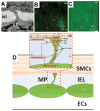Modeling Ca2+ signaling in the microcirculation: intercellular communication and vasoreactivity
- PMID: 22196162
- PMCID: PMC3681513
- DOI: 10.1615/critrevbiomedeng.v39.i5.50
Modeling Ca2+ signaling in the microcirculation: intercellular communication and vasoreactivity
Abstract
A network of intracellular signaling pathways and complex intercellular interactions regulate calcium mobilization in vascular cells, arteriolar tone, and blood flow. Different endothelium-derived vasoreactive factors have been identified and the importance of myoendothelial communication in vasoreactivity is now well appreciated. The ability of many vascular networks to conduct signals upstream also is established. This phenomenon is critical for both short-term changes in blood perfusion as well as long-term adaptations of a vascular network. In addition, in a phenomenon termed vasomotion, arterioles often exhibit spontaneous oscillations in diameter. This is thought to improve tissue oxygenation and enhance blood flow. Experimentation has begun to reveal important aspects of the regulatory machinery and the significance of these phenomena for the regulation of local perfusion and oxygenation. Mathematical modeling can assist in elucidating the complex signaling mechanisms that participate in these phenomena. This review highlights some of the important experimental studies and relevant mathematical models that provide the current understanding of these mechanisms in vasoreactivity.
Figures




Similar articles
-
Vasomotion - what is currently thought?Acta Physiol (Oxf). 2011 Jul;202(3):253-69. doi: 10.1111/j.1748-1716.2011.02320.x. Epub 2011 May 27. Acta Physiol (Oxf). 2011. PMID: 21518271 Review.
-
Intercellular communication in the vascular wall: a modeling perspective.Microcirculation. 2012 Jul;19(5):391-402. doi: 10.1111/j.1549-8719.2012.00171.x. Microcirculation. 2012. PMID: 22340204 Free PMC article. Review.
-
Mechanisms of cellular synchronization in the vascular wall. Mechanisms of vasomotion.Dan Med Bull. 2010 Oct;57(10):B4191. Dan Med Bull. 2010. PMID: 21040688 Review.
-
Regulation of blood flow in the microcirculation: role of conducted vasodilation.Acta Physiol (Oxf). 2011 Jul;202(3):271-84. doi: 10.1111/j.1748-1716.2010.02244.x. Epub 2011 Mar 1. Acta Physiol (Oxf). 2011. PMID: 21199397 Free PMC article. Review.
-
Role of myoendothelial communication on arterial vasomotion.Am J Physiol Heart Circ Physiol. 2006 Nov;291(5):H2036-8. doi: 10.1152/ajpheart.00709.2006. Epub 2006 Jul 28. Am J Physiol Heart Circ Physiol. 2006. PMID: 16877557 No abstract available.
Cited by
-
Apoptosis in resistance arteries induced by hydrogen peroxide: greater resilience of endothelium versus smooth muscle.Am J Physiol Heart Circ Physiol. 2021 Apr 1;320(4):H1625-H1633. doi: 10.1152/ajpheart.00956.2020. Epub 2021 Feb 19. Am J Physiol Heart Circ Physiol. 2021. PMID: 33606587 Free PMC article. Review.
-
Synchronization and Random Triggering of Lymphatic Vessel Contractions.PLoS Comput Biol. 2016 Dec 9;12(12):e1005231. doi: 10.1371/journal.pcbi.1005231. eCollection 2016 Dec. PLoS Comput Biol. 2016. PMID: 27935958 Free PMC article.
-
Stochastic model of endothelial TRPV4 calcium sparklets: effect of bursting and cooperativity on EDH.Biophys J. 2015 Mar 24;108(6):1566-1576. doi: 10.1016/j.bpj.2015.01.034. Biophys J. 2015. PMID: 25809269 Free PMC article.
-
Intercellular Ca(2+) waves: mechanisms and function.Physiol Rev. 2012 Jul;92(3):1359-92. doi: 10.1152/physrev.00029.2011. Physiol Rev. 2012. PMID: 22811430 Free PMC article. Review.
-
Applications of computational models to better understand microvascular remodelling: a focus on biomechanical integration across scales.Interface Focus. 2015 Apr 6;5(2):20140077. doi: 10.1098/rsfs.2014.0077. Interface Focus. 2015. PMID: 25844149 Free PMC article. Review.
References
-
- Sandow SL, Haddock RE, Hill CE, Chadha PS, Kerr PM, Welsh DG, et al. What’s where and why at a vascular myoendothelial microdomain signalling complex. Clin Exp Pharmacol Physiol. 2009;36(1):67–76. - PubMed
-
- Tallini YN, Brekke JF, Shui B, Doran R, Hwang SM, Nakai J, et al. Propagated endothelial Ca2+ waves and arteriolar dilation in vivo: measurements in Cx40BAC GCaMP2 transgenic mice. Circ Res. 2007;101(12):1300–9. - PubMed
-
- Luo CH, Rudy Y. A dynamic model of the cardiac ventricular action potential. I. Simulations of ionic currents and concentration changes. Circ Res. 1994;74(6):1071–96. - PubMed
Publication types
MeSH terms
Substances
Grants and funding
LinkOut - more resources
Full Text Sources
Miscellaneous

